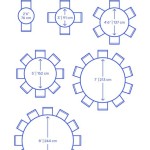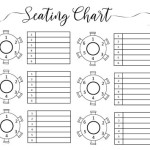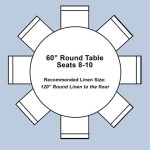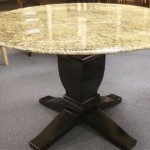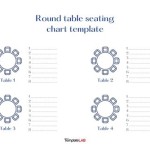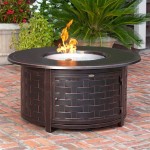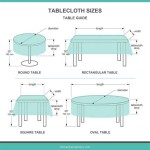What Size Round Table Seats 6-8 People?
Determining the appropriate size for a round table that comfortably accommodates 6 to 8 people requires careful consideration of several factors. These include the available space in the dining area, the desired level of comfort for diners, and the potential for the table to be used for purposes beyond dining. Understanding these factors will ensure the selected table size provides an optimal dining experience and complements the overall aesthetic of the room.
The primary measurement to consider is the diameter of the round table. The diameter dictates the circumference, which directly influences the amount of usable surface area available for each diner. Insufficient diameter can lead to overcrowding, making it difficult for guests to comfortably enjoy their meals and engage in conversation. Conversely, an excessively large diameter can overwhelm the room and create an uncomfortable distance between diners, hindering interaction.
Accurate measurement of the intended space is crucial before deciding on a table size. Consider the room's dimensions and any existing furniture to ensure adequate clearance for chairs to be pulled out and for people to move freely around the table. A common guideline recommends leaving at least 36 inches (3 feet) of space between the edge of the table and any walls or other furniture. This allows for comfortable movement and prevents the dining area from feeling cramped.
The style of dining experience also plays a significant role. A formal dining setting may necessitate a larger table to accommodate elaborate place settings, multiple courses, and serving dishes. In contrast, a more casual dining environment might allow for a slightly smaller table size. Evaluating the typical meal service and the desired ambiance will help narrow down the ideal diameter.
Beyond dining, consider if the table will be utilized for other activities, such as board games, homework, or crafts. If the table will serve multiple purposes, a slightly larger diameter might be preferred to provide ample workspace. Flexibility in table usage can significantly enhance its value and practicality.
Key Point 1: Minimum Diameter for Comfortable Seating
For a round table to comfortably seat 6 people, a minimum diameter of 48 inches (4 feet) is generally recommended. This allows approximately 24 inches of personal space per diner, which is considered the minimum for comfortable elbow room and plate placement. However, for 8 people, a 60-inch (5-foot) diameter is generally required to maintain a similar level of comfort. Increasing the diameter ensures that each diner has adequate room to maneuver and enjoy their meal without feeling cramped.
The 24-inch guideline is a standard benchmark in dining arrangement. It accounts for the typical width of a dinner plate, silverware, and glassware, along with the necessary elbow room for diners to eat comfortably. While this measurement can be slightly reduced in informal settings, prioritizing comfort is essential, especially when hosting guests.
When considering the minimum diameter, also factor in the thickness of the table's edge. Some tables have decorative edges or thick surfaces that can slightly reduce the usable surface area. It's recommended to account for this by adding an extra inch or two to the overall diameter to ensure adequate space for diners.
Families with young children might find that a slightly larger table is preferable, even if they are only seating 6 people. This provides extra room for spills, art projects, or other activities that require additional surface area. Anticipating the needs of the household and considering future usage are pivotal in selecting the appropriate table size.
Furthermore, the shape and style of the chairs will influence the required table diameter. Chairs with wide arms or bulky designs will necessitate a larger table to avoid overcrowding. Before finalizing the table size, it's advisable to measure the width of the chairs and factor this into the overall space planning. This proactive approach helps prevent unforeseen issues with seating arrangements.
Key Point 2: Maximizing Space and Room Layout
While a larger diameter offers more comfort, it's imperative to assess the available space in the dining area. A table that is too large can overwhelm the room, making it difficult to navigate and creating an uncomfortable dining environment. As previously mentioned, maintaining at least 36 inches of clearance between the table and walls or other furniture is crucial for comfortable movement.
The shape of the room also influences table placement. In a square room, a round table can be particularly effective in creating a sense of balance and openness. However, in a narrow or rectangular room, it might be more challenging to accommodate a large round table without obstructing traffic flow. Consider the room's architecture and how the table will integrate into the existing layout.
Utilizing a floor plan or a virtual room design tool can be invaluable in visualizing the table's impact on the space. These tools allow for experimenting with different table sizes and layouts to determine the optimal configuration. By digitally simulating the room, it's possible to identify potential challenges and avoid costly mistakes.
Consider the placement of other furniture in the dining area, such as sideboards, buffets, or display cabinets. These pieces can further restrict the available space and influence the optimal table size. Ensure that there is sufficient room to access these items without disrupting diners or creating a cluttered environment.
For smaller dining areas, consider opting for a round table with a pedestal base. Pedestal bases take up less floor space than traditional four-legged tables, allowing for more legroom and easier maneuverability around the table. This design can be particularly beneficial in making the room feel more spacious and less cramped.
Key Point 3: Material and Style Considerations
The material and style of the round table should complement the overall aesthetic of the dining room. Different materials offer varying levels of durability, maintenance requirements, and visual appeal. Wood tables, for example, provide a classic and timeless look, while glass tables offer a more modern and minimalist aesthetic. The choice of material should align with the homeowner's personal preferences and the existing décor.
Solid wood tables are known for their durability and longevity. They can withstand daily use and are relatively easy to repair if damaged. However, wood tables can be susceptible to scratches and water stains, requiring regular maintenance to maintain their appearance. The type of wood also influences the table's durability and aesthetic. Hardwoods like oak and maple are more resistant to dents and scratches compared to softwoods like pine.
Glass tables offer a sleek and modern look that can brighten up a dining room. They are easy to clean and resistant to stains. However, glass tables can be prone to scratches and chips, and they may require tempered glass for safety. The transparency of glass can also make the dining area feel more spacious, particularly in smaller rooms.
The table's style should also integrate seamlessly with the existing décor. A traditional dining room might benefit from a round table with ornate carvings and a rich wood finish. In contrast, a contemporary dining room might be better suited to a sleek, minimalist table with clean lines and a metal or glass base. Consider the overall style of the room and choose a table that complements the existing furniture and accessories.
The table's base style also influences its overall appearance and functionality. As mentioned earlier, pedestal bases offer more legroom and are ideal for smaller spaces. On the other hand, four-legged tables provide more stability and can accommodate larger loads. Consider the intended use of the table and choose a base style that meets those needs.
In addition to material and style, consider the finish of the table. A glossy finish can reflect light and make the dining area feel brighter, while a matte finish offers a more subdued and sophisticated look. The finish should also be durable and resistant to scratches and stains. Choose a finish that complements the table's material and style and that is easy to maintain.

Choosing The Right Dining Table Size Your Ultimate Guide Cabinfield Blog

Wedding Planning Tools Table Sizes Seating Happily Connected

Everything About Your Round Dining Table For 8 People

Everything About Your Round Dining Table For 8 People

Round Tables Types Materials Benefits And More

Round Dining Table Dimensions

Complete Guide To Patio Tables Bonus Styling Tips

48 Round Tables Seats 8 People Event Als Nyc Brooklyn

100 Round Table For 6 Dimensions Best Home Furniture Check More At Http Livelylighting Com

4 Steps For A Dining Table Guide
Related Posts

